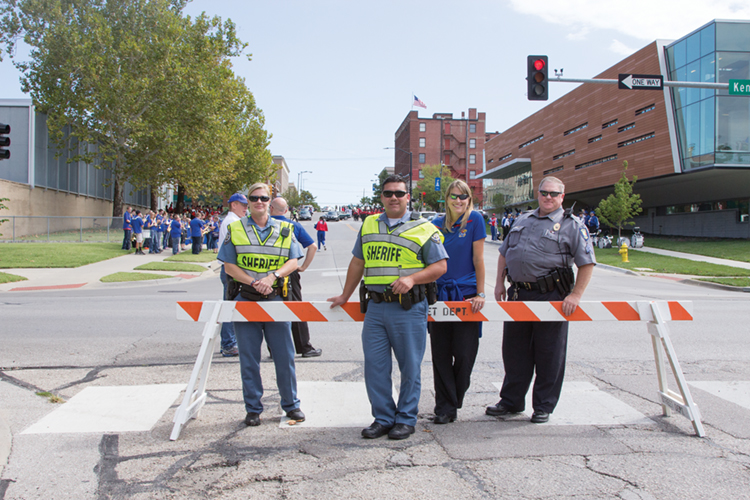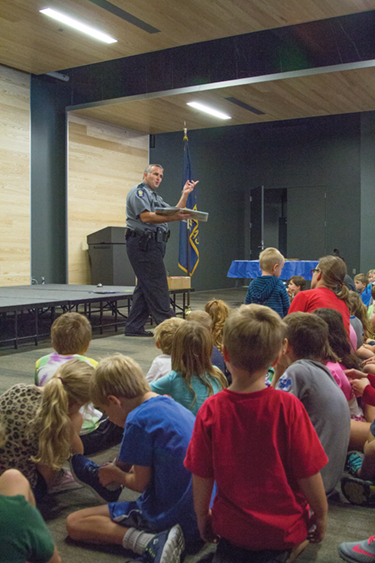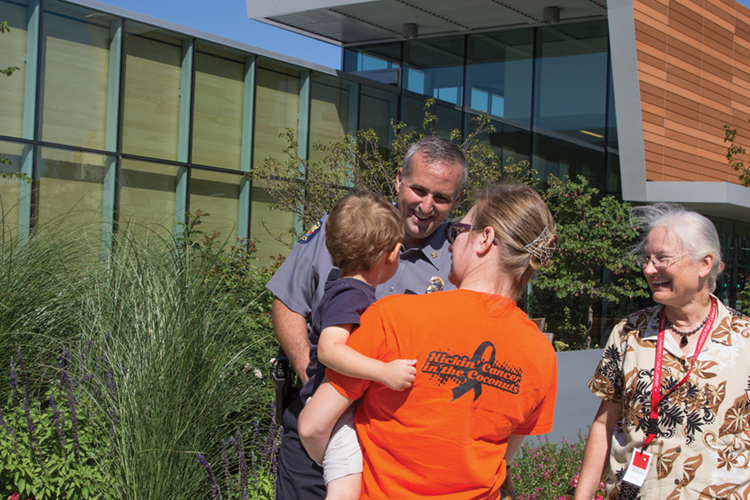Men and Women in Blue
| 2015 Q3 | story by ANNE BROCKHOFF | photos by STEVEN HERTZOG |

Chief Tarik Khatib
Like so many other Lawrence residents, Tarik Khatib arrived here as a University of Kansas student more than 25 years ago. And like thousands of other students, he headed downtown in 1988 to help celebrate the Jayhawks’ NCAA Division I men’s basketball championship win.
Little did he know that he would someday be chief of the Lawrence Police Department, in charge of law enforcement and public safety at events like that, as well as in everyday life. What started him down that path?<\br><\br>
“I really fell in love with the community,” says Khatib, who lives here with his wife and two children. “Those things that make Lawrence incredibly hard to police also make it incredibly cool to live here.”
The police department serves a growing population of some 90,000 culturally diverse residents, plus a regular influx of students and visitors drawn by KU and Haskell Indian Nations University. The city’s 33-square-mile footprint has some 314 miles of streets, and commercial, residential and recreational developments continue to expand.
Lawrence residents are civically engaged, with citizens, neighborhood organizations, business leaders and other groups routinely weighing in on police issues. That’s a good thing, says Khatib, who sees the community as a vital partner in fulfilling the department’s mission.
“My experience with the community is that Lawrence has high expectations of its police department,” he says. “Whether that’s to do with event management, interaction with community members, solving cases—all those things. Lawrence wants to have a full-service police department.”
Meeting those expectations with what in 2015 is a $17.5-million budget can be challenging. The department needs to add employees, improve technology and build a new facility if it’s to succeed, Khatib explains.
“We want to build infrastructure, we want to build amenities; but you don’t have a police structure to protect all that,” he says.
The department’s needs are a surprise to some, he says, given that it appears to be doing fine with what it has. Lawrence’s total crime rate fell to 33.8 crimes per 1,000 residents in 2014, from 55.2 in 2009. Violent crime fell to 3.08 per 1,000 from 5.0 in the same period, according to a memorandum addressing the department’s operations and strategic plan that Khatib sent to city managers on July 16.

Working Together on Band Day
Residents are mostly happy, too. The 2015 City of Lawrence Citizen Survey showed 80 percent of respondents were satisfied or very satisfied with police officers’ professionalism and 77 percent with their response time to emergencies.
That can make funding requests for necessary resources a tough sell, Khatib says, but curtailing investment can have disastrous consequences.
“If you’re a business owner, and you don’t do your job right, you go out of business,” Khatib says. “If you’re a police department, and you don’t do your job right, you don’t go out of business. You just slowly deteriorate and atrophy over time, and at some point in the future, you really mess up.”
That analogy resonates especially now, given the violent protests following last year’s police shooting in Ferguson, Mo. Understanding the relationship that department had with its community is essential, Khatib says, which is why he made a Justice Department report on its actions required reading for his own employees.
“We’re not them, but there are lessons to be learned,” Khatib says. “We don’t ever want to become them.”
Tarik Khatib was born in Beirut, Lebanon, and lived there until war broke out in the late 1970s. Khatib was 11 when his family joined his American mother’s family in Lake Forest, Ill., for what they hoped would be only a short time.
“The plan was to ride out the hostilities,” he says. “Those that had the wherewithal to get out got out. Unfortunately, those who didn’t had to suffer 20 years of civil war.”
Khatib grew up in the North Chicago suburb and then attended KU. He graduated in 1991 with a degree in sociology, an interest in law enforcement and a passion for public service. He considered joining the military but then spotted a recruiting ad for the Lawrence police department. Khatib applied, was accepted and, in June 1992, joined the force as a patrol officer on the late-night shift.
“I immediately really enjoyed working with and interacting with the community and the public,” he says.
That enjoyment continued through three years on patrol during turns as an officer in narcotics, training and field training, and then as a sergeant on patrol in drug enforcement and the investigative division. Khatib was then promoted to captain on patrol and, eventually, captain of information technology and technical services.
When Ron Olin announced his retirement as police chief in 2010, Khatib put his name in for the position. He was chosen as interim chief in September of that year and took over permanently in February 2011.
“I like to think I’ve come up through the department,” he says. “It’s important to have an understanding of the inner workings of the department. It helps me make better decisions.”

Sgt. Max Miller, incident commander for the Band Day parade
In late 2010, the department began a review of its personnel, equipment and facilities needs, and Khatib began figuring out how to meet them. One of his top priorities: improving technology.
Since then, the department has coordinated with the Douglas County Emergency Communications Center to install its Computer Aided Dispatch (CAD) system. CAD is more efficient, and it allows for better data collection. That data is expected to greatly improve transparency, particularly when it comes to race and law enforcement, the July 16 memorandum says. An improved web site, dedicated public affairs officer and other information-analysis capabilities also boost transparency, the memo says.
The department upgraded its records-management system and replaced radio equipment, while a recent mill levy increase allowed for new in-car video systems, mobile data computers, body armor, tactical equipment, Taser electronic control devices and information technology infrastructure. Perhaps just as critical is the department’s ability to ensure ongoing upkeep and maintenance of it all.
“What’s new is that we can actually support what we have,” Khatib says.
The Lawrence Police Department has also grown in size. It currently has 152 commissioned officers and 33 civilian support staff, including a patrol service dog program. But Khatib says it needs another 30 officers and 10 staff to meet the city’s needs.
Many downtown business owners would like additional foot or bicycle patrols, he says, while an increased police presence in areas like the South Iowa corridor could deter shoplifting and property crime.
To address some of those needs, the department implemented Data Driven Approaches to Crime and Traffic Safety (DDACTS), a program that pinpoints crime hot spots, and restructured its patrol division to better deploy officers during busy times.
“If I’ve got someone pulled over for speeding, and the lights are on, that creates a chilling effect on crime,” Khatib says. “Business owners know that and want more activity, but we’re challenged.”

Chief Khatib
Money is part of the issue; the department needs more if it’s going to hire more personnel. But even with funding, attracting the right people isn’t easy. Media portrayals of law-enforcement officers, both fictional and real, have altered potential recruits’ perception of the job, Khatib explains.
At the same time, agencies must compete against the legal, medical, business and other professions for top candidates. Unlike those careers, law enforcement comes with odd hours, fiscal uncertainty, stressful working conditions and a degree of personal risk.
“It’s a tough sell,” admits Khatib, who recalls that when he joined the force, there had been 600 applicants for four positions. Now, 200 might apply for 10 jobs.
“This is not just the Lawrence police department. This is across the nation,” Khatib says. “Those departments that can best attract and best train the best recruits are going to get the best officers, and they’re going to have better outcomes.”
While it’s difficult to quantify the economic impact of adding officers, the price of violent crime is clear. Violent crimes impose concrete costs on victims and families, as well as lower property values, spur higher insurance premiums and reduce investment in the communities where they occur, according to a 2012 study by the Center for American Progress, an independent nonpartisan policy institute.
Even non-violent crime hits the bottom line. Adding more police is one approach to reducing that, but it’s difficult to financially quantify the benefit.
“It’s hard to measure that because the cost of the police officer is seen in the city’s budget. Somebody has to find the money,” Khatib says. “The benefit of hiring a police officer is not in the city budget.”
Better policing is about more than numbers, though. How a department approaches its task is crucial, too. Khatib’s embraced community policing, which the International Association of Chiefs of Police website DiscoverPolicing.org defines as developing community partnerships, engaging in problem-solving and implementing community policing organizational features.
In Lawrence, that means building relationships with citizens, community groups and other agencies over time, and requiring all officers to interact as positively as possible with the public.
“There is an expectation of a certain level of interaction with the community,” Khatib says. “We expect officers to exercise a certain level of humility and a servant style of leadership and service.”
Departmental training addresses not only the skills needed while responding to calls and investigating crimes, but also how to increase non-confrontational interactions with the public. That might be at any of the 60 or so parades, game days and other events (including NCAA tournament celebrations) throughout the year.

Chief Khatib
Or, it could be participating in neighborhood meetings and picnics, visiting schools, making presentations and meeting with minority populations. Officers also support programs like a police camp for kids, Boys and Girls Club of Lawrence Birthday Beat and Blue Santa, and serve on dozens of boards including Big Brothers and Big Sisters of Douglas County, Just Foods and Willow Domestic Violence Center.
The idea is to be proactive in solving problems of concern to the community, including those surrounding the issue of race. The department’s newly renamed Citizen Advisory Board for Fair and Impartial Policing advises it on racial and other bias-based policing issues, and dealing with those biases is an integral part of its training programs.
Such training ensures “to the best extent possible (officers) are conscious of their biases and making sure they don’t use their biases in the way they go about doing their duties,” Khatib says.
Employees also receive mental-health training through a program developed with the help of the Bert Nash Community Mental Health Center. And a new program created by the Douglas County Crisis Intervention Training Council, together with Baldwin, Eudora, Douglas County and other agencies, will soon begin.
Other efforts focused on leadership, crisis response, diversity, fair and impartial policing, as well as peer support and stress management, further improve readiness.
Still, one challenge overshadows all of these efforts: the need for a new facility.
“Part of recruitment, training, retention—all those things we talk about —is having adequate facilities,” says Khatib, who believes what the department now has is wholly inadequate.
The department now operates out of six locations: the Law Enforcement Center on 11th Street; the Investigations and Training Center on Bob Billings Parkway; Animal and Parking Control near 9th and New Hampshire streets; a Morton block building on east 15th Street that’s used for property storage; a facility on Stone Barn Terrace where response vehicles are housed; and the Douglas County Public Works Shop on east 23rd Street, which includes property and evidence storage.
That adds up to 37,489 square feet, or less than half of what the department needs to function efficiently, according to a Lawrence Police Department PowerPoint presentation on facilities needs. And all of it suffers from safety, structural, security, accessibility and space limitations.
“We need a facility that fits our department now,” says Khatib, who says a facility could cost $25 million to $30 million.
As focused as Khatib is on facility, training, technology and other structural issues, though, he’s never lost his enthusiasm for public service or his love for the job. Despite all the changes during the years, he says, the core appeal remains.
“Law enforcement is still about people. It’s still about interacting with the community,” Khatib says. “It’s still about customer service and investigative curiosity as a police officer. Those things are the same.”

14 Comments
馬子にも衣装
豚に真珠
tyboi.vin chăm sóc khách hàng chuyên nghiệp
saoclub.now uy tín được nhiều người tin tưởng
yiffy
shittiest
I was recommended this blog by my cousin. I’m not sure whether this post is written by him as nobody else know such detailed about my problem. You are amazing! Thanks!
Good day! I could have sworn I’ve visited this site before but after browsing through many of the articles I realized it’s new to me. Regardless, I’m certainly delighted I found it and I’ll be bookmarking it and checking back frequently!
Saved as a favorite, I like your blog!
Everything is very open with a really clear explanation of the issues. It was truly informative. Your website is very helpful. Thanks for sharing.
This excellent website definitely has all of the information I wanted concerning this subject and didn’t know who to ask.
A fascinating discussion is definitely worth comment. I do think that you ought to write more about this topic, it might not be a taboo subject but typically folks don’t talk about these topics. To the next! All the best.
I seriously love your site.. Very nice colors & theme. Did you create this website yourself? Please reply back as I’m looking to create my very own blog and would love to learn where you got this from or exactly what the theme is named. Kudos!
Thanks for the ideas you have provided here. Additionally, I believe there are a few factors which really keep your motor insurance premium straight down. One is, to take into consideration buying motors that are from the good report on car insurance organizations. Cars which have been expensive tend to be more at risk of being snatched. Aside from that insurance is also depending on the value of the car, so the costlier it is, then the higher the actual premium you pay.